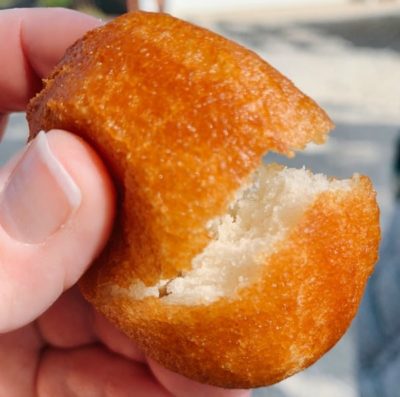Today’s episode is a Family Cookbook episode that I’ve wanted to make for quite a while. It features two of my favorite foods from the area where I went to college (and where MANY of my ancestors lived for over a century) – Deep Fried Biscuits and Homemade Apple Butter, from Indiana. See the below for the recipes.
The part of the apple butter recipe that fascinates me is that my mother’s mother would have gone through all of the boiling and sealing of jars as a child and teenager, basically the whole canning process, and by the time she died she was using a microwave. We’re never that far from history and continual evolution, even in the kitchen.
Also, I invite you to celebrate my birthday with me, help me promote my YouTube channel in three easy steps, and with that, enter to win a deck of playing cards (design of your choice) from my Zazzle shop.
Let’s get cooking!
![]()
Nashville House Fried Biscuits, Nashville Indiana
1 quart of milk
1/4 cup of sugar
2 2/3 pkg of dry yeast or 1/6 cup of yeast
1/2 cup lard or shortening
6 teaspoons salt
7-9 cups of flour
Add yeast to warm water. Add other ingredients & let dough rise. Work into biscuits and drop into hot fat.
This recipe will make about seven dozen biscuits. They can be frozen individually and stoed in plastic bags. When you work them up, don’t let the biscuits rise too high. The fat should be slightly hotter than 350 degrees F. If fat should be too hot, the biscuits will be soggy in the center.
The Hancock Democrat (Greenfield, Indiana), 18 Oct 1917, Page 2
Apple Butter
There is no better way to use good apples and the sound portions of windfall, wormy and bruised apples than to make apple butter of them. While al most ail varieties or apples win make good apple butter, those with distinctive flavor and good cooking quality are most satisfactory. Sur-h old standard varieties as Northern Spy, Rhode Island Greening, Tompkins King and Smokehouse are excellent for this purpose. The summer varieties also will make good apple butter, it has been found by recent tests in the United States Department of Agriculture.
If apples of coarse texture are used it is desirable to cook them and put them through a colander or coarse wire strainer before adding them to the boiled cider. Sweet apples are sometimes used with tart apples. Overripe apples are not desirable.
Apple butter is made by boiling down fresh, sweet cider to half its original quantity, then adding apples which have been peeled and sliced. The apples either are added directly to the boiled cider and cooked in it until the apple butter is done, or are made into apple sauce, which is cooked in the boiled cider. The cooking should be continued until the cider and apple pulp do not separate; then the butter will be of the right thickness when cold.
It takes usually about equal parts of sweet cider and peeled and sliced apples to make butter of the right consistency. In other words, if five gallons of sweet cider are used, it should be boiled down to two and one-half gallons and five gallons of peeled and sliced apples should be added, either raw or made into apple sauce.
Two things essential to making good apple butter are: Long, slow cooking (four to six hours) and constant starring. If sugar is used it should be added after the cooking of cider and apples is about two-thirds done. About a pound of either white or brown sugar is the usual amount per gallon of apple butter, but more or less, or not any, may be used to suit the taste.
Apple butter is spiced according to one’s preference, about half a teaspoonful each of ground cinnamon, cloves and allspice for each gallon being a common mixture. These are stirred into it when the cooking is finished. While still boiling hot apple butter should be packed in hot sterilized glasses, glass jars or hermetically sealed stone jars, or crocks -with tightly fitting covers and be sterilized in steam as follows: Set the containers filled and with tops on in a vessel fitted with false bottom and deep enough to hold them, pour in a little water, put the cover on to hold in the steam and set over the fire. Begin to count tinif when the steam starts to escapp and after five minutes (ten minutes for half gallon or fifteen for larger containprs) take the containers out to cool, then set them away for future use. Do not disturb the covers until the apple butter is to be used. If the covers do not fit tightly place waxed or oiled paper in them to make a tight fit before sterilizing is done. This sterilizing is done for the purpose of preventing any spoiling of the top layers of apple butter and also to taks the place of a layer of paraffine which, though a good seal, is now quite expensive. All fruit butters and similar products should be sterilized in the same way.
 Copyright secured by Digiprove © 2022 Carolynn ni Lochlainn
Copyright secured by Digiprove © 2022 Carolynn ni Lochlainn
Podcast: Play in new window | Download
Subscribe: RSS

